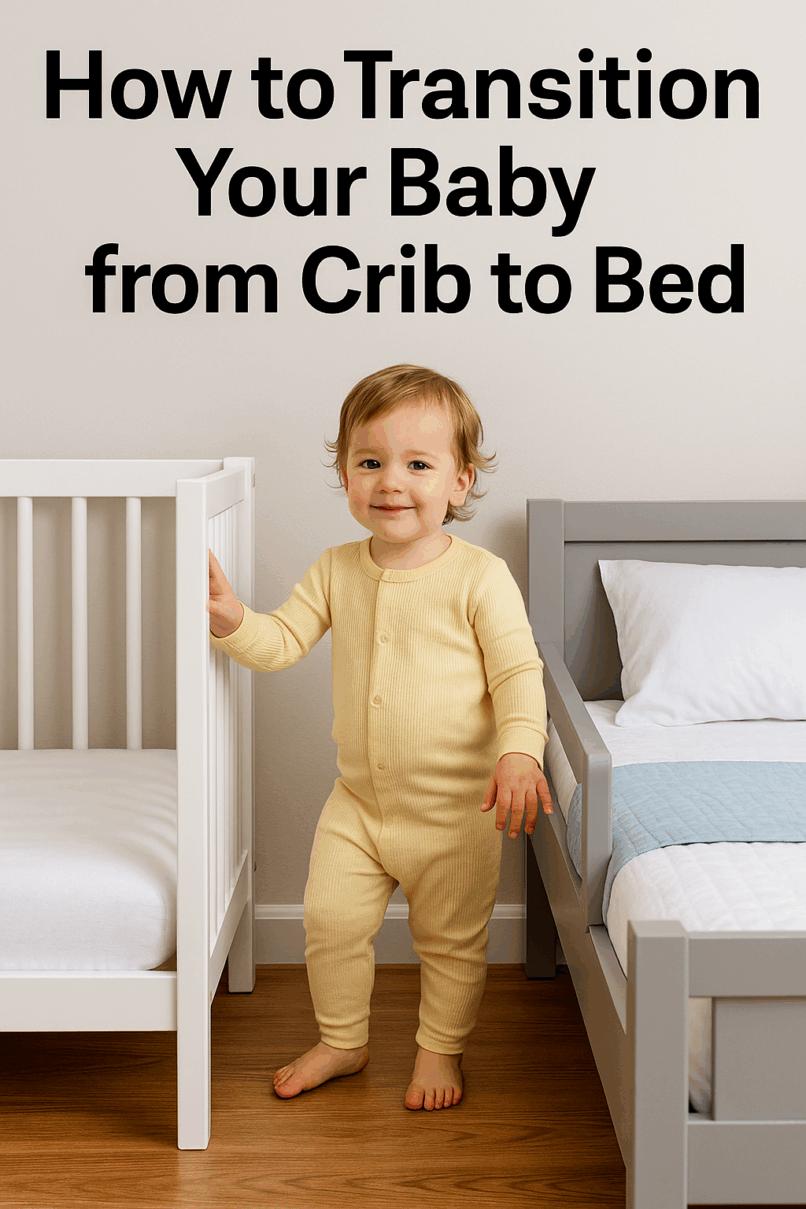
simply amazing, always for you.
When your baby is born, every milestone feels monumental—first smiles, first steps, first words. But one change that often catches parents by surprise is the shift from crib to bed. It seems simple: your child outgrows the crib, so you move them into a bigger bed. But for many families, this change can bring sleepless nights, emotional resistance, power struggles, and even safety concerns.

If you’re standing at the edge of this transition and wondering how to go about it, you’re not alone. In this comprehensive guide, we’ll walk through everything you need to know to successfully move your child from a crib to a bed—while maintaining routines, sanity, and sleep.
Chapter 1: Understanding Why the Transition Matters
Let’s be honest: this isn’t just about swapping furniture. The move from crib to bed signals the beginning of your child’s growing independence. It’s often the first time your child is free to get in and out of bed without help. This physical freedom introduces a psychological shift for both parent and child.
In many ways, this move is a test run for how your child handles freedom, boundaries, and routine without constant confinement. It’s an opportunity to instill self-regulation skills early on. But mishandled, it can lead to weeks of bedtime battles and regression.
A thoughtful, patient approach to the crib-to-bed transition can support your child’s emotional growth and build trust between you.
Chapter 2: The Right Time to Transition
There’s no “perfect” age that fits every child, but most toddlers make the transition between 18 months and 3.5 years. Some children switch earlier due to climbing out of the crib (a safety issue), while others stay in cribs longer because they sleep soundly and aren’t showing signs of readiness.
Signs Your Child Might Be Ready:
- Climbing out of the crib: Once your child figures out how to escape, the crib is no longer safe.
- Outgrowing the crib: If they look cramped or too tall for the space.
- Toilet training: If you’re starting night-time potty training, your child will need to access the toilet independently.
- Expressing interest: If your child shows curiosity about your bed or says they want a “big kid bed,” it might be time.
Avoid making the transition during other big life changes like moving, starting daycare, or welcoming a new sibling. Too many changes at once can overwhelm your child emotionally.
Chapter 3: Choosing the Right Bed
The right bed can ease the transition significantly. Here are your main options:
1. Toddler Bed
- Made for children aged 1.5 to 3.5 years.
- Low to the ground and fits a crib mattress.
- Often comes with safety rails and child-friendly designs.
2. Twin Bed with Guardrails
- A more long-term option.
- Use side rails for safety until your child adjusts.
3. Montessori Floor Bed
- A mattress on the floor or on a low frame.
- Encourages independence.
- Eliminates the risk of falling from a height.
Safety First:
- Keep beds away from windows and wall hangings that can fall.
- Use outlet covers and secure all cords.
- Anchor furniture to prevent tipping.
This is also a good time to re-evaluate your child’s room with a safety-first lens. Now that they’re mobile, the room should be a secure and inviting place, not a hazard zone.

Chapter 4: The Emotional Side of the Transition
We often focus on the logistics—bed size, mattress firmness, bedtime routines—but forget the emotional impact. Your child has probably spent their entire life sleeping in their crib. It’s a familiar, safe space.
The move can stir up anxiety, resistance, and even grief. That’s normal. Some children adapt quickly. Others cling to the crib as a symbol of comfort. Understanding and validating your child’s emotions is key.
How to Emotionally Prepare Your Child:
- Talk about it often, days or weeks before the switch.
- Use age-appropriate books to introduce the concept.
- Involve your child in choosing bedding, pillows, or the bed frame.
- Avoid pressure or ultimatums.
Your child may ask for the crib again. Be gentle but firm. It’s okay to acknowledge their feelings while keeping the transition moving forward.
Chapter 5: Practical Steps for a Smooth Transition
1. Stick to the Routine
Bedtime routines are the anchor of sleep training at any age. Maintain familiar steps: bath, pajamas, story, cuddles, sleep. The sequence creates comfort and predictability.
2. Make It Fun and Special
Frame the change as a reward or milestone. Celebrate “big kid bed day” with a special dinner or gift. Let your child feel proud, not punished.
3. Start with Naps (Optional)
If you want a slow transition, try naps in the new bed first. This gives your child time to adjust in short increments.
4. Keep the Crib in the Room (Temporarily)
Some parents leave the crib set up during the early days of the switch. This provides comfort while your child adjusts. Gradually phase it out.
5. Use Reinforcement
Positive reinforcement goes a long way. Praise your child for staying in bed or falling asleep independently. Use sticker charts or small incentives, but avoid bribing or threatening.
Chapter 6: Dealing with Common Challenges
Night Wandering
Toddlers often explore their freedom by leaving bed repeatedly. Stay calm. Gently guide them back. Be consistent.
Avoid conversations or negotiations at this time. A simple, “It’s bedtime,” said quietly and lovingly, will do.
Night Waking
Your child may wake more frequently after the switch. Provide reassurance, but don’t create new sleep crutches like staying in their bed or letting them sleep in yours—unless that’s your preference long-term.
Regression
It’s common for children to sleep well in their new bed for a few nights and then regress. This is normal. Don’t panic. Stay the course.
Chapter 7: Sleep Training Methods During the Transition
Sleep training doesn’t end with the crib. Here are a few toddler-friendly strategies:
1. Chair Method
Sit in a chair near the bed. Gradually move it farther away each night until you’re out of the room.
2. Leave-and-Check
Leave the room after bedtime. Check on your child at timed intervals if they’re upset. Comfort briefly, then leave.
3. Silent Return
When your child gets out of bed, walk them back silently and without drama. Repeat as needed.
Consistency—not perfection—is the key to making these methods work.
Chapter 8: Should You Use a Bedtime Gate?
If your child repeatedly leaves their room, a child-proof doorknob or baby gate can help. It keeps them safe and prevents hallway wanderings at night. Just ensure they don’t feel trapped. Let them know it’s for safety, not punishment.
Chapter 9: Preparing Yourself as a Parent
You might be more emotional than you expect. Letting go of the crib can feel like saying goodbye to babyhood. Be kind to yourself. The goal isn’t to rush independence—it’s to support your child as they grow.
Tips for Parents:
- Talk to other parents about their experiences.
- Expect and accept some sleep disruption.
- Don’t second-guess yourself every time there’s a rough night.
- Celebrate small wins. Staying in bed all night? That’s worth a happy dance.
Chapter 10: Books and Resources to Ease the Transition
Reading to your child about the change can normalize their fears and spark excitement.
Recommended Books:
- Big Enough for a Bed (Sesame Street)
- Bye-Bye Crib by Alison McGhee
- I Sleep in a Big Bed by Maria van Lieshout
- Your Own Big Bed by Rita Bergstein
These stories introduce the new bed as an adventure, not something to fear.
Chapter 11: Stories from Other Parents
Every family’s transition is unique. Some breeze through it. Others struggle. Here are a few real-world examples that might help you feel less alone:
“We let our daughter pick her new bed set—unicorns everywhere. It gave her a sense of ownership. The first few nights were hard, but by week two, she loved it.” —Joy, mother of two.
“My son was terrified of sleeping without the crib rails. We added a stuffed animal ‘guard’ and told him it would protect him. Worked like magic.” —Kip, dad of a three-year-old.
“We transitioned our twins at the same time and used a reward chart. They loved competing to see who got more stars. It turned into a game.” —Angela, mom of four.
Chapter 12: How Long Does It Take?
There’s no set timeline, but on average:
- First 3 nights: Resistance or curiosity-driven behavior.
- Week 2: Improved settling and understanding of boundaries.
- Week 3-4: Full adaptation for most children.
Regression can happen weeks or even months later. Be flexible but consistent. Your child is learning more than how to sleep in a new bed—they’re learning how to adapt to change.
A Growth Opportunity Disguised as Bedtime Chaos
Transitioning from crib to bed is more than just a phase—it’s a moment of transformation. It teaches your child confidence, routine, and the art of self-soothing. And it gives you, the parent, a front-row seat to one of childhood’s quietest but most powerful milestones.
Your approach can shape how your child feels about sleep, independence, and boundaries in the months and years ahead. Take it one night at a time. Celebrate the good nights. Learn from the hard ones.
After all, like every other parenting challenge, this too shall pass—and may even become one of the stories you’ll laugh about one day.
So, what kind of bed are you considering for your child—and what’s your biggest worry about making the switch?
SUGGESTED READS
- How to Teach Your Kids About Gratitude During the Holiday Season
- How to Manage Parenting and Holiday Trips: The Ultimate Guide for Stress-Free Family Travel
- Ultimate Guide to Parenting During the Holiday Season: Keep the Joy, Ditch the Stress
- How to Make Your Child’s Birthday Truly Special: A Complete Guide to Unforgettable Memories
- 51 Healthy Snacks Your Kids Will Actually Love (No More Fights at Snack Time)
- How to Keep Your Child Active and Healthy in the Digital Age

Support Our Website!
We appreciate your visit and hope you find our content valuable. If you’d like to support us further, please consider contributing through the TILL NUMBER: 9549825. Your support helps us keep delivering great content!
If you’d like to support Nabado from outside Kenya, we invite you to send your contributions through trusted third-party services such as Remitly, westernunion, SendWave, or WorldRemit. These platforms are reliable and convenient for international money transfers.
Please use the following details when sending your support:
Phone Number: +254701838999
Recipient Name: Peterson Getuma Okemwa
We sincerely appreciate your generosity and support. Thank you for being part of this journey!
